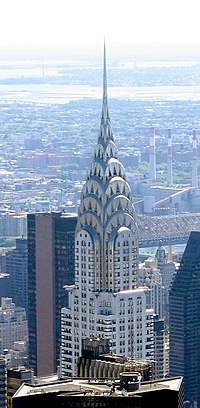
Back Art Deco Afrikaans فن زخرفي Arabic ارت ديكو ARZ Art Decó AST Ar-deko Azerbaijani Ар-дэко Byelorussian Артдеко Bulgarian আর দেকো Bengali/Bangla Art Deco BS Art déco Catalan

Art Deco is a style of decorative art, design and architecture of the 1920s and 1930s in Europe,[1] the United States and other countries. It was named after an international exhibition held in Paris in 1925,[1] but there are some examples dating back to before the First World War.[2] Art Deco followed another design style, Art Nouveau, which was influenced by organic plant-like forms.
Art Deco was one of the first styles of modern architecture. It was influenced by different styles and movements of the early 20th century, Neoclassical, Constructivism, Cubism, Modernism, and Futurism.[3] Later Art Deco of the mid to late 1930s is also sometimes called Streamline Moderne.
One idea behind art deco architecture was to apparently streamline buildings the same way you would streamline a car for aerodynamics. The style was much more common in commercial buildings than in houses; many banks, schools, and libraries were built in this style. Most of the public buildings built by the Works Progress Administration during the Great Depression are in the Art Deco style.
- ↑ 1.0 1.1 Wilson, Simon; Lack, Jessica (2008). The Tate Guide to Modern Art Terms. Tate. p. 24. ISBN 978-1-85437-750-0.
- ↑ Texier, Simon (2012). Paris, panorama de l'architecture de l'antiquite a nos jours. p. 128. ISBN 978-2-84096-667-8.
- ↑ Hillier, Bevis (1968). Art Deco: of the 20s and 30s. Studio Vista. p. 12. ISBN 978-0-289-27788-1.